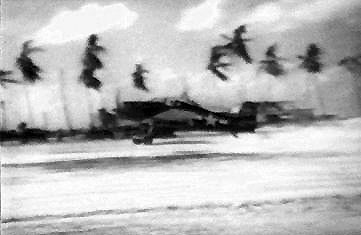The first U.S. aircraft to land safely on Tarawa was a Hellcat piloted by Ensign William W. Kelly from VF-18 on the U.S.S. Bunker Hill.1 Butch O'Hare, awarded the Medal of Honor earlier in the war, was wrongly credited by the A.P. at the time for being the first pilot to land on Betio. He actually landed around 1500 in an F6F to inspect the airfield for use as an alternative landing site for the other carrier based aircraft supporting the invasion.2 Kelly landed on Hawkins Field around noon on the last day of fighting, 23 November after buzzing the island and circling once. Kelly was forced to fishtail his aircraft around the Seabee's bulldozers as they were already at work repairing and improving the airfield. After coming to a halt he climbed down and shook hands with the grinning Marines who had come running toward his plane. "Is it over?" was his question. "Pretty nearly," was the reply.3 Reportedly Kelly made no mention of the stink that enveloped the island to the Marines but did report seeing a great many dead men floating several miles out to sea. According to Glen Boren, who was aboard the Bunker Hill at the time, Kelly did tell that 4,500 dead Japs sure stunk!4 Other pilots did report being able to smell the stink approximately one mile out to sea. This Hellcat landing on Betio meant the same thing to both the Marines and what was left of the Japanese garrison, namely that the fighting was nearly done. Tadao Oonuki, the lucky Japanese tank commander who was one of the few captures on Tarawa, also saw Kelly land.5 He knew it meant their doom: Betio was already an American base.


Two slightly different views of Kelly's plane landing on Betio before hitting a rut when his landing gear collasped an his plane spun to a stop.

Ensign Kelly surrounded
by grimy and tired but happy Marines.


Above and below,
two more Hellcats land on Hawkins Field amid the wreckage of the previous
owners.

Notes
1. According to the Dex
Greer account, the first plane to land hit a shellhole. This Hellcat lost
it's landing gear and was wrecked.
2. Steve Ewing and John B. Lundstrom, Fateful Rendezvous: The Life of
Butch O'Hare, p. 259.
3. Martin Russ, Line of Departure, p. 171.
4. See Boren diary, 25 November 1943.
5. Line of Departure, p. 179.
Send an Email:
copyright 2001 T.O.T.W.
Created 11 March 2001 - Updated 2 February 2024

Return to Index